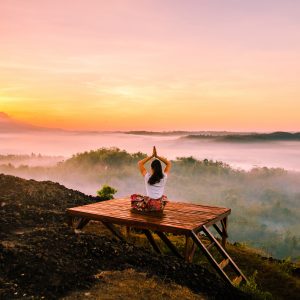By Caitlin Linscheid
How many times have you heard the advice “wash your hands and don’t touch your face” in the last two weeks? How many times has the person delivering that message been actively touching their face? The best advice for avoiding Covid-19 sounds easy enough, but most Americans seem to be discovering that they are almost never not touching their face.

A Public Health Official licks her finger immediately after encouraging people to avoid touching their eyes, nose, or mouth
As a massage therapist I’ve spent my entire career practicing good hand hygiene and training myself to resist the urge to touch my face (or really anything that isn’t my client) from the time I wash my hands before heading into session until I’ve washed and dried them after session. While it is absolutely a learn-able skill it takes more effort than you’d think.
A behavioral observation study found that a group of med students (who should really know better) touched their faces an average of 23 times per hour during lectures. A German study that asked participants to complete a memory test while unpleasant sounds were played over a loudspeaker reached the conclusion that spontaneous face-touching may help humans regulate their emotions. One recent study even suggests that a fetus will engage in facial self-touch in reaction to maternal stress (and are specifically more likely to use their left hand). On top of all that deep-seated wiring our little pocket of the world has just sprung into bloom meaning most of us are experiencing more sensation around the nose and eyes than usual.
Whether it’s a tool to help you focus, a self-soothing activity during stress, or you’re just suffering from allergies, chances are you’re engaging in facial self-touch a little too often for the CDC’s liking.
But what can you do about it?
Mindfulness Meditation is often associated with images of yogis and monks sitting quietly in an isolated environment.
While that may be a nice ideal and a good starting point for your practice, the truth is mindfulness is a tool for coping that is going to provide more benefit to your life if you can employ it in your day to day.

Fun fact: if you type “stress” into a stock image search you get a gallery of people TOUCHING THEIR FACES
In the case of figuring out how the heck to stop touching your face cultivating a mindfulness meditation practice is an excellent tool for actively fighting the spread of Covid-19.
Mindfulness is essentially the practice of becoming aware of your thoughts and the sensations that are present in your body and separating yourself from them. The thoughts don’t stop. The sensations don’t stop. But you do not have to engage or identify with them.
I’m going to repeat that last bit:
THE THOUGHTS DON’T STOP. THE SENSATIONS DON’T STOP.
The number one myth of meditation is the idea that if your mind is not completely empty and serene the whole time, then you are somehow doing it wrong. You will continue to experience the stress in your life. You will continue to experience the sensations in your body. What mindfulness offers is not complete freedom from negative circumstances. Instead it gives you a buffer. A brief window of time where you can pull back from the thought or sensation, examine the information that it has to offer you, and consciously choose what to do with that information.
Most people who seek out this practice are approaching it from the angle of cultivating calm in times of emotional turmoil, but you’ll notice that I keep mentioning sensation. This practice allows you to consciously choose how you react to physical sensation as well.
I begin every one of my yoga classes by inviting my students to come into a comfortable seated posture and take a few breaths. Focus on bringing your attention into your body and the sensations that are present there.
What feels tight? What feels sore? What feels flexible? Where do you feel heavy? Where do you feel light? Where do you feel your breath moving your body? Do any of these sensations bring up a judgemental thought? Can you try to let go of that judgement and just be present with what is?
Can you transform your discomfort into information?
When I was a student in university I was very much a “head holder.” I often sat at my desk with a hand under my chin and my knuckles resting on my lips. When I sleep I often bury my face in my pillow or my hands. My seasonal allergies tend to manifest as itchy, watery eyes and nose.
When I became a massage therapist my mindfulness practice expanded from controlling my reactions to my thoughts and I began controlling my reactions to my sensations. Lately I’m having to expand that practice beyond simply being in session and into my every day:
I’m attending a leadership training. Can I set my posture up and away from the table I’m seated at to resist the temptation to plant an elbow and hold my head?
I’m heading to bed. Can I wash my hands one last time and change my pillow case?
My face itches. If I take a few breaths without scratching does the sensation pass? If not can I be present with that discomfort until I have an opportunity to wash my hands? If not can I take a calculated risk about the surface of my body that I use to scratch my itch?
If you are struggling to shift your habits and patterns to accommodate living in a world where a pandemic has been declared, I invite you to try mindfulness. It isn’t a magic bullet and it’s a slow-grow practice (I’m 10 years in and still learning), but it’s a place to start.

